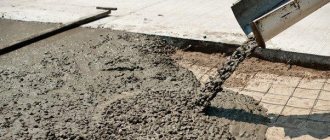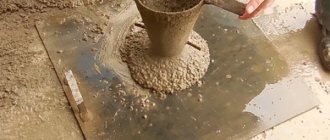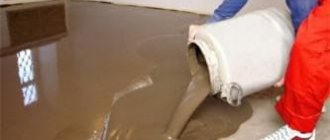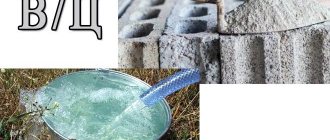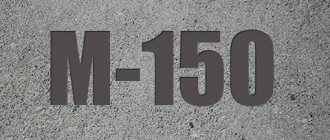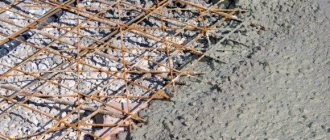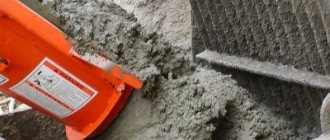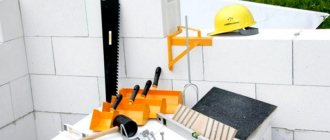Cement is perhaps the most common building material among summer residents and owners of private houses. It is used to make concrete for pouring the foundation, mortar for laying bricks and plaster. And it is very convenient for these works to quickly calculate the amount of required components of the concrete mixture. The presented online concrete calculator serves precisely for these purposes.
Information on the purpose of the calculator
Online calculator for calculating and selecting the composition of heavy concrete on a cement binder using coarse and fine aggregates. Taking into account plasticizing additives, compaction method and mobility of the concrete mixture. The calculation is approximate and may differ from the real one, depending on the materials used, their humidity and other characteristics. To more accurately determine the proportions, it is necessary to carry out a test batch.
To calculate the proportions for one batch in a concrete mixer, it is necessary to indicate the amount of concrete equal to the working volume of the concrete mixer (60-70% of the total).
Drawing up proportions
To know how many kg of cement needs to be used to prepare a cube of mortar, use special calculators, tables, etc. But it happens that the cement purchased is of a lower grade than what is required according to the standards. In this case, it is allowed to increase the cement in a cube of concrete by 15%, and sand by 10%, to increase strength. But it’s better to calculate everything in advance and mix it according to GOST.
As a rule, cement is supplied in bags of 50 kilograms. In such a container it is convenient to load/unload, transport, and store. However, it is worth remembering that cement cannot be stored for a long time, as it quickly absorbs moisture and becomes unsuitable for work. And the shelf life is usually 6-12 months from the date of production.
To find out how many bags of cement are needed per cube of concrete, you need to divide the mass of the powder by 50 kilograms. Thus, in the preparation of M300 concrete, 329 kilograms of cement are used. This means that you will need 329 / 50 = 6.58 bags (or 6 bags and 29 kilograms). This figure is multiplied by the number of cubic meters of solution that is planned to be used: for example, if you need 21 cubic meters, then to prepare the mixture you need to purchase 6.58 x 21 = 138.18 bags.
To prepare a high-quality mixture that meets all the characteristics, it is best to choose cement grades M400/M500, which are most suitable for repair and construction work. The correct proportions when using different grades of cement are shown in the table:
Brief description of heavy concrete
Reinforced concrete products for construction are manufactured not only at specialized enterprises, but are also very often cast directly at the site being constructed. Not a single construction site is complete without concrete. To create a reliable structure with specified technical characteristics, heavy concrete is used, which, in accordance with building codes, has a volumetric mass of over 1,800 kg/m3.
Distinctive features of heavy concrete
The production of building materials is carried out in two categories: light and heavy concrete products. They differ significantly in physical and technological characteristics and, accordingly, in scope:
- Lightweight concrete
- Heavy concrete
— are produced on the basis of “light” fillers, which significantly reduce the bulk density and increase the thermal insulation properties. In addition, the lighter the concrete, the greater its porosity, which means low hydraulic resistance, so products made from lightweight concrete are used for internal non-critical structures without a strong dynamic destructive effect.
— characterized by high strength and low porosity, which guarantees excellent resistance to any mechanical and chemical influences. Building materials made from heavy concrete are applicable for especially critical structures with open (natural) operation, including for the construction of foundations, walls, and pouring floors.
Characteristics of heavy concrete
Calculation and selection of the composition and proportions of heavy concrete is carried out taking into account the required characteristics (properties):
- Strength
- Thermal expansion and fire resistance of heavy concrete
- Porosity, water resistance and frost resistance
– the main indicator of the ability of reinforced concrete products to withstand destructive loads. It is this indicator that indicates the area of application of concrete in high-rise buildings, foundations or hydraulic structures. The indicator is classified from B3.5 to B60, which corresponds to the tensile strength marking from M50 to M1000 (from 5 to 100 MPa).
– an indicator of the possibility of using building products in temperature affected areas. Thus, pouring a floor made of heavy concrete has an expansion coefficient of no more than 0.5 mm per linear meter. Concrete can withstand temperatures up to 500 degrees (higher destruction occurs), and at a temperature of about 200 degrees its strength is lost by no more than 30%.
– related indicators, the sum of which determines the operational resistance of reinforced concrete products. The porosity of heavy concrete should not exceed 15%. Frost resistance is marked by its ability to withstand cyclic freezing from F50 to F1000. Heavy concrete is used in the construction of canals and bridges, so their water resistance is within the marking range W2 - W20 (the number is an indicator of the impact of water in kgf/cm2).
Application of heavy concrete
It is very important to correctly calculate and select the composition and proportions of heavy concrete, because The brand of concrete produced and its areas of application depend on this:
— Particularly critical structures and hydraulic structures must be erected from concrete of a grade not lower than M500.
— Critical structures, foundations and walls of high-rise buildings, slab foundations are made of concrete M250 - M350.
— Individual construction can be carried out with M150 – M200 concrete.
— Non-essential concrete products for paths, blind areas and elements of road or landscape design can be cast with strength M50 - M150.
The calculation of the composition of heavy concrete is carried out according to the methodology in accordance with GOST 27006 - 86 (1989) “Concrete. Rules for the selection of compositions" and GOST 7473 - 94 "Concrete mixtures. Technical conditions".
Structural features of heavy concrete
The composition and proportions of the components used for heavy concrete directly affects its technological and physical characteristics, so the calculation must be carried out quite accurately, which is more convenient to do using an online calculator. To cast high-quality concrete products with suitable technical characteristics, it is necessary to take into account a number of features of the production of heavy concrete:
- There are always two types of fillers used: large-format and small-format.
- Plasticity of concrete or workability
Large-format aggregates (crushed stone or gravel) ensure the strength of concrete, and small-format aggregates, due to compacted distribution, increase the density and reduce the porosity of concrete. Filler of large formats with angular shapes provides less shrinkage of the casting and high operational dynamic strength. The fraction of fine aggregate also affects the characteristics of the concrete product: the finer it is, the higher the density and water resistance. It is worth considering that the strength of the concrete casting itself depends on the strength of the large-format aggregate.
– the ability of the concrete mixture to completely fill the form being poured with sufficient compaction to guarantee its design strength. Plasticity is marked from P1 (minimum) to P5 (maximum). To fill open areas using compaction (vibration) technology, you can take P1 concrete, but for complex structures it is necessary to use highly plastic concrete solutions from P3 to P5.
Water is an important calculation ingredient, the addition of which in excess is not permissible.
It is a mistake to think that adding water can increase the plasticity of concrete without harming its quality, because its uniformity and strength decrease and shrinkage increases. To increase the plasticity of concrete, plasticizers are used, which improve the ability to move fillers, which guarantees high-quality filling of the mold and easy release of air from the casting with a uniform structure of the entire concrete. Professional construction necessarily uses plasticizers.
Mobility of concrete mixture
The mobility of a concrete mixture is the most important indicator of workability, which shows the possibility of a method (manual or using mechanisms) of high-quality filling of the form of concrete structures for various applications:
- Zh2
- Zh1
- P1
- P2
- P3
- P4
– applicable for massive reinforced concrete structures and support platforms. The use of vibration compaction equipment is mandatory.
– concrete mixtures for the construction of wall structures for civil and industrial purposes. It is permissible to fill small forms without mechanical compaction, but volumetric products can only be manufactured using vibration compaction.
– it is recommended to carry out casting directly at the site of construction of the structural element. The mobility is applicable for the manufacture of thin-walled products with reinforcement of no more than 1%. In private construction, slabs, supports and beams of small cross-section are cast with manual and mechanical compaction.
– used for critical reinforced (more than 1%) structures: beams, elements of bunkers and bridges. The manufactured parts have increased strength. Depending on the shape, manual or mechanical compaction is used.
– concrete with excellent filling capacity, poured into slipforms with reinforcement greater than 1%. Particularly popular in both private and commercial construction. In some cases, it is necessary to use a vibrator to fill complex forms efficiently.
– the solution easily fills any forms of formwork without the use of vibrators, so this concrete is very popular in private construction: casting foundations, wall and slab structures. In addition, a solution with plasticity P4 is ideal for filling forms with dense reinforcement of more than 1%, while the quality of installation is ensured by simple bayoneting.
The following is a complete list of calculations performed with a brief description of each item. If you haven't found the answer to your question, you can contact us via feedback.
What does consumption depend on?
The main and most important requirement for a concrete solution is compliance with the specified strength parameters after going through the full cycle of the hardening process. It is for this purpose that they determine how much cement is needed per 1 cubic meter of concrete, calculate the volumes of other components, and carefully monitor compliance with the technology for preparing the solution.
You can find the proportions in specialized reference books. But, in addition, you need to remember that cement consumption per 1 m3 depends on many factors that must be taken into account in the process of mixing concrete mortar.
What affects the consumption of cement in concrete:
- Operational parameters of concrete mortar - grade strength, density, setting time, water resistance, frost resistance, etc.
- Comfort of working with the solution - the required indicators of mobility, plasticity, which may largely depend on the ambient temperature and other factors.
- Characteristics of sand - grain size, type, volume of impurities: the sand should not contain more than 15% impurities, otherwise the filler must be washed, sifted, dried, etc.
- Characteristics of crushed stone - stone density, flakiness, level of contamination (if it does not meet the requirements, it is also advisable to wash and dry it).
- The need to introduce additional components into the composition - if the solution contains plasticizers and additives, then the number of bags of cement per cubic meter of solution may be less/more.
When calculating how much cement is needed per 1 cubic meter of concrete, be sure to take into account the brand of the powder itself and the solution that needs to be obtained in the end. It is desirable that the grade of cement be one and a half to two times higher than the grade of the mixture being mixed.
The higher the grade of cement, the smaller its volume in the solution. But you should not exceed the mark too much and take M600, for example, to fill a floor: oversaturation of the mixture can give a negative result.
General information on the calculation results
- Amount of cement
- Amount of water
- Amount of fine and coarse aggregates
- Density of concrete mixture
- V/C
- Proportions
- Price
— The total estimated amount of cement required for the entire volume.
— The total estimated amount of water required for the entire volume.
— The total amount of fine and coarse aggregates for the entire volume in kilograms.
— Density of the concrete mixture in its wet state.
— Water-cement ratio of the concrete mixture.
— Relative ratio of concrete mixture components. C - part of cement; P - part of fine aggregate; Ш – part of coarse aggregate; B is part of the water.
— The cost of each material and the total for the entire volume.
Mixture components
So, if the previous calculation shows how much volume of each component is needed to prepare one cubic meter of concrete, then there are also calculations that show how much of this concrete is required for a particular job.
Making them is quite simple.
Strip foundation
Calculation of the amount of concrete for a strip foundation is carried out based only on the dimensions of the strip or cast part of the foundation.
To find out the amount of mixture required, you need to calculate the volume of this casting part. In turn, for this it is necessary to know all the geometric dimensions of the foundation.
For example, a rectangular foundation. Its dimensions are as follows:
- the perimeter, that is, the length of all four sides, is 20 m;
- the width of the foundation strip is 40 cm;
- The laying depth is 1 m.
If the tape has the shape of a parallelogram, that is, smooth walls and ribs formed by two sides at an angle of 90 degrees, then the volume of such a figure is calculated as the product of all three sides. Then we get:
20*0.4*1 = 8 cubes of concrete. Knowing the exact quantity of all materials, you can easily calculate the quantity of each separately.
Columnar base
The cross-section of a columnar foundation can be rectangular, square or round.
If we are talking about a columnar foundation, the pillars of which are presented in the form of the same rectangles, that is, they have a square or rectangle in their cross-section, then the quantity is calculated as the sum of the values for each pillar. In this case, the volume of each column is calculated by analogy with the previous example.
If we are talking about pillars with a round cross-section, then this parameter is calculated as follows.
First you need to calculate the volume of one column, and then sum them all up. If we neglect the fact that the cross-section of the pillar is not a perfect circle, then this value can be established using the usual geometric formula for a cylinder, that is, the height of the pillar is multiplied by the cross-sectional area, or the area of the circle.
The area of a circle is calculated as Pi multiplied by the square of the radius. Let's assume that the pillar has a diameter of 40 cm. Then the area is calculated as follows:
- set the radius, which is equal to half the diameter, that is, 40/2 = 20 cm;
- Let's calculate the cross-sectional area (that is, the area of a circle with a radius of 20 cm), knowing that the number Pi is approximately 3.14, we get 3.14*0.2*0.2 = 0.1256 m2;
- Now let’s calculate the volume by taking the height of the column equal to 2 m, it turns out 0.1256*2 = 0.25 m3.
Knowing that one column requires a quarter of a cubic meter of solution, and assuming that all the columns have the same shape and height, you can multiply their total number by the resulting result or simply divide by 4.
Installation of strip foundation formwork
The formwork is usually made of planed boards approximately 40-50 mm thick. You can use slate for this purpose.
When erecting formwork, control verticality. The recommended height of the frame above the ground is 30 cm. This is necessary to build a small base. Asbestos concrete pipes are laid in the formwork to introduce sewerage and water supply into the building.
Place a plastic film between the concrete and the formwork; this will protect the formwork from contamination.
Shallow strip foundation
A shallow foundation saves both budget and time. And labor costs will be significantly less, since its construction does not require a deep pit. The following foundation is used for lightweight structures of small area:
- wooden houses
- aerated concrete structures or buildings constructed from aerated concrete and foam concrete blocks, the height of which does not exceed 2 floors
- monolithic buildings with permanent formwork
- small structures built of stone
The depth of the shallow foundation reaches half a meter.
